#yamato fan club
Text
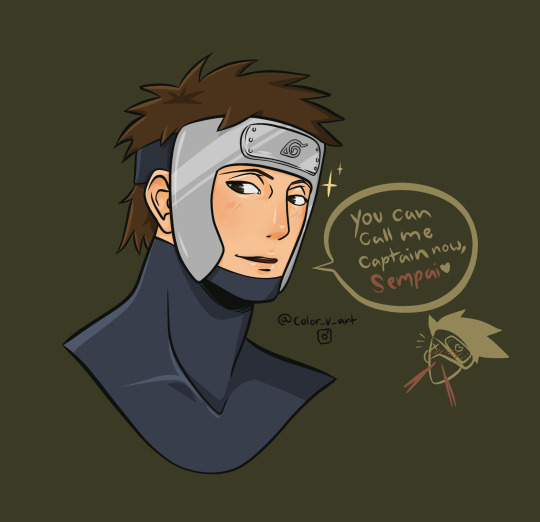
When your cute little kohai gains some confidence 😏🪵🪵
#art#tenzou#yamato tenzo#naruto characters#yamato#kakayama#captain yamato#fun doodles#veronica miller#naruto shippuden#digital art#kakashi senpai#my tree boi#confident#kakashi loves his kohai#kakashi x yamato#yams#call me captain#naruto fanart#yamato fan club#fanart
245 notes
·
View notes
Text

Apparently Oblivious
Character: Yamato
Reader: gender neutral
Word Count: 1037
CW: fluff, oblivious Yamato, first kiss, post top surgery Yamato, reader is being very obviously horny for Yams but the text is wholly sfw
A/N: raffle prize for @mysticaltigersorceress who asked for some oblivious himbo Yamato in front of some flirting :3 I hope the murder is successful :3

For a loud ball of enthusiastic chaos he’s so predictable it hurts. He’s sitting exactly in the same place as yesterday, and the day before, and even before, ever since he arrived on your island. As if he made this udon stall his home, he keeps returning around lunchtime, squeezing his huge body by the counter and cradling the bowl in his enormous hand. The bowl you’re barely able to hold with both hands.
The sight always has you weak in knees: he’s so big in every aspect of his body and personality, jarring and warm like the sun. Claiming to be a samurai of a legendary land of Wano, he looks like none you heard about them, resembling more a half-feral friendly spirit. Or a giant puppy, with this wild maze of white and blue hair. His body is full of scars, from wrists to two horizontal cuts across his wide chest, but his moves around you are gentle as if you were a noble, not a random person who keeps him company during lunch. You haven’t tested that—yet—but you bet he could fit your middle between hands and carry you around like a doll. Or sit you on one of his thick thighs so you could bury your face right between his pecs.
And sometimes, when he smiles exceptionally wide, you can’t help but wonder how it would feel to graze his fang-looking canines with your tongue.
Even his name is attractive. Yamato. You like the way it sounds and tastes.
You’ve sworn to yourself that you would have this man yours at least once before he leaves the island.
“The usual?” Stall owner greets you and already reaches for the noodles. You nod and squeeze yourself by Yamato’s side, not without a little, subtle brush of hand against his knee.
A polite man he is, he hunches to the other side. Of course.
“Y/N!” You like the way he speaks your name too, with that adorable vibrato of foreign accent and untamable enthusiasm. “Hi! How have you been? How is your day going?”
“Good.” And it would be even better if you finally made the puzzles in his head click. “And yours? What did you explore this time?”
“The ruins in the north.” He stuffs his mouth with noodles, his cheeks full much like a hamster's. Despite his fingers being enormously huge, he uses chopsticks with smooth precision. You would stare at his hands only for this reason if your attention wasn’t already swallowed by their sheer size.
“Hey, doesn’t it take, like, a whole day just to get there?”
“Not for me. I’m fast!”
Oh, you have no doubt in it. Those muscled legs must turn him into a god of wind whenever he moves, even if he carries that gigantic club everywhere with himself. You saw him once swinging it around, so easily as if it was a little twig.
The weight of your body would mean nothing for him. Just a thought of it makes you shiver a little.
“You’ve dozed off.” Yamato waves hand in front of your face. Hand much bigger than your face, currently heating up.
“Oh, sorry, maybe I don’t really feel that good,” you feign, leaning against him. This time he doesn’t dodge, quite contrary: lets you press close exactly where you aim. His bicep feels sooo good against your cheek, so soft and ready to flex.
Stall owner rolls his eyes, places your udon in front of you, and retreats to the back.
“Shit, should I call a doctor?” Yamato frowns, his gaze heavy and concerned. He leans over you and presses forehead against yours. Your heart skips a whole starved beat as you fight the urge to grab his horns. “You don’t have a fever. Good.”
“I don’t? But I feel like burning…” You fan yourself with a shirt, trying to angle yourself with his gaze. But his eyes do not wander down, towards the naked skin of your chest. Of course, he’s a good boy.
“Maybe it’s because of broth— Ah, no, you haven’t even started your udon.”
If you weren’t in public, you would jump onto his lap out of frustration.
“I will once it chills down enough. Maybe you will try for me—”
Before you can reach for your chopsticks, Yamato snatches some noodles with his own. So much for the sneaky plan of feeding him…
“Hot!” He hisses, adorably sticking the tip of his tongue out. Fanning himself with a hand, he looks around, frantically, for water or ice, anything—
Now or never.
One hand grabbing his shirt, you pull him close and dart your own tongue out. You brush it against his, putting all the yearning, willpower, and skill into shamelessly teasing him. It’s fast, short, and far from what could be called a kiss. But his face is tomato-red by the time you pull away.
“Here—” you smirk and hope for the best— “I kissed you better.”
Yamato’s eyes are wide open, as if on the verge of popping out, and his tongue still hangs out. Hands he reflexively put on your shoulders twitch, at times squeezing you harder and stirring thoughts of less innocent caliber.
“H-hey…” He can barely choke out without pulling the tongue back in, his easy-going, smooth demeanor gone in seconds. “That was…nice.”
“Would you like me to kiss you again?” You pull on the string without hesitation. Your target finally pulled on the bait—and you’re not losing the time on the game of blind cat and confused mouse.
He blinks. Comically slowly. And finally hides his tongue.
“R-right in front of—” His eyes shoot on side, right at the stall owner, who just waves off and bolts between boxes at the back, promising he can’t see anything and never could, of course. “Oh. Okay. Alright then?”
Ready to pull him in again you gasp in surprise when it’s him who makes the move: fast, smooth, and confident. Yamato’s big, warm hand—so close to your fantasies, yet so different—envelops your head with ease as he guides you in for the promised kiss.
And then he proves to you that his adorable innocence is the first of many false assumptions you’ve made about him.
#yamato x reader#yamato x you#yamato x y/n#one piece x reader#one piece x you#one piece x y/n#one piece imagine#one piece scenario#one piece reader insert#bas writes#yamato#gender neutral reader#5k raffle
324 notes
·
View notes
Text
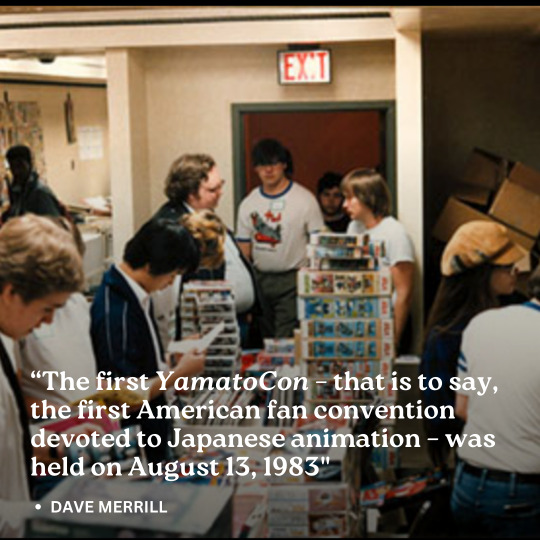
Anime conventions and their Yamato roots
by Dave Merrill
“Conventional” (ha ha) wisdom says that the first American convention devoted to Japanese animation was Project A-Kon 1990 in Dallas, Texas. This prototypical event was instigated by a group of Texas anime fans gathered under the banner of Star Blazers’“Earth Defense Command,” a Space Battleship Yamato fan club that grew to embrace all of Japanese animation. As of this writing, Project A-Kon is preparing for its 20th show.
But was A-Kon the first anime convention in North America? No. Not even close. For years, we’d seen references and offhand comments about a “YamatoCon” that was held in the Dallas area years earlier. Were these references true? Our crack team of researchers donned their explorer togs, dusted off their pith helmets, and began the harrowing search for enlightenment. Well, to be honest we sent some emails. Here’s what we found…

The first YamatoCon – that is to say, the first American fan convention devoted to Japanese animation – was held on August 13, 1983 at the Harvey Hotel in Dallas Texas. This one-day affair was the brainchild of Mark Hernandez, Don Magness, and Bobb Waller, each of whom had experience in the Dallas comics/SF fandom community and each of whom put up their own hard-earned cash to make YamatoConhappen. Scheduled the next-to-last weekend before school started, Mark Hernandez remembers the planning being as simple as getting commitments from dealers, finding a venue, and setting a date. Yes, it really is that easy to start a convention.
Programming consisted of the first 26 episodes of Star Blazersrecorded off TV, shown in continuous order (minus commercials, of course) and a bonus Yamato film. This 13-hour Journey to Iscandar (“It was a long day,” says Mark) was a primary attraction at YamatoCon, 1983 being a time when VCRs and blank VHS tape were expensive, collections of Star Blazers on video were hard to come by, and the experience of watching Star Blazers outside the morning or afternoon UHF timeslot was a draw in and of itself.
Star Blazers on video wasn’t the only activity, of course. Like other conventions past and future, YamatoCon had a dealers room consisting of 22 tables of for-sale memorabilia. It might sound small by the standards of 25 years later, but we must remember that anime merchandise of the day – what was available in the States, anyway – hadn’t achieved the tidal wave proportions it would reach in the wake of Robotech, to say nothing of the total saturation of the post-Pokemon, post-Sailor Moon years. Anime merchandise in 1983 consisted chiefly of books and model kits. Roman Albums, Anime Comics, black and white manga volumes, the occasional manga weekly, and other publications streaming from Japan in the wake of the Yamato Boom battled for the anime fan dollar alongside model kits from Yamato, Crusher Joe and My Youth In Arcadia…not to mention the endless ranks of giant robot kits from unseen shows like Mobile Suit Gundam, Dougram, Ideon, and something called Macross.Along with the remnants of late 70s super-robot merchandise sold here as Shogun Warriors, the anime con dealers room in the early 1980s was far from barren. In fact, I still waste my money on that sort of stuff.
Also available at YamatoCon were copies of Mark Hernandez and Don Magness’s Star Blazers fanzine Argo Notes. Future EDC officer/contributor, fan artist and “Between Galaxies” author Logan Darklighter won the model contest with, naturally, a Yamatomodel. It proved to be a pivotal day in Texas anime fandom. Approximately 100 attendees and 8 dealers made the show an unqualified success. Don remembers it this way: “I remember we got to the hotel early and set up the rooms, then went out to breakfast. When we got back, there were 3 young men sitting on the front steps, one of them had a convention flyer. Mark asked if they were there for the con, and they said they were. We went inside and out of their hearing range and had a little celebration. 3 people had come! We had no idea that the place would soon be packed.”
A showing of 100 might not sound like a lot in today’s numbers (“that was about 100 more than we expected,” said Don). However, when considered against the attendance at general SF conventions in 1983 – a time when your absolute largest cons MIGHT draw five or six thousand attendees and your typical Dallas or Atlanta comic book show maxed out at three – YamatoCon‘s ability to nail down that many dealers and customers is commendable.
The show’s importance went beyond the one day; people across Texas and indeed, across fandom as a whole, who were unable to attend or who heard about it after the fact were spurred into action by the mere fact of YamatoCon‘s existence. That such a thing could happen – that Americans could organize and hold a successful anime convention – was both revelation and reassurance. Anime fandom was going to be more than just a video room grudgingly tacked onto the local Star Trek show or a half-page of merchandise in the back of the latest issue of Fangoria.
READ THE REST HERE https://ourstarblazers.com/vault/317/
50 notes
·
View notes
Text
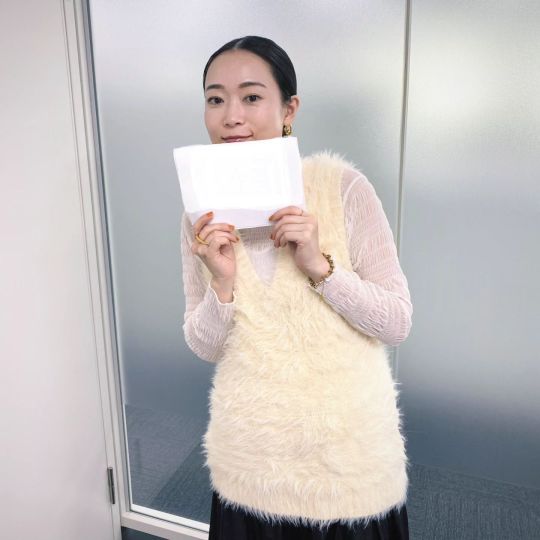

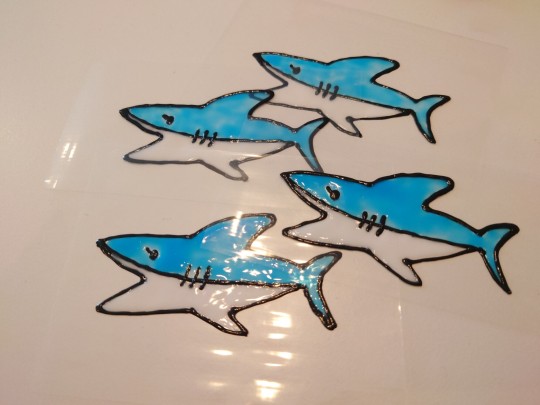
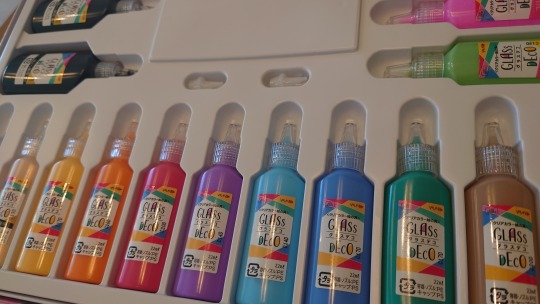

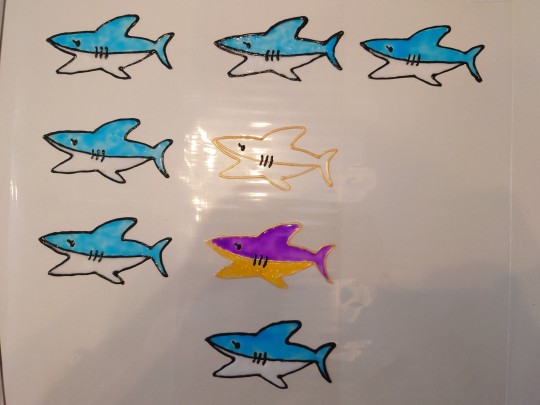

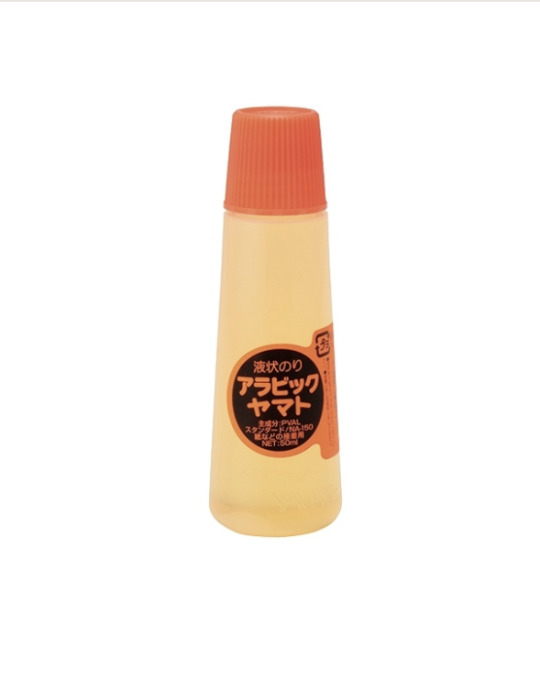

2023/11/10 Blog post by Wakana おしゃべりガーデン第3回目‼︎〜記憶喪失者続出の七五三〜
❗This is Fan Club EXCLUSIVE content❗
❗PERSONAL USE ONLY❗
Do ❗NOT SHARE❗ on other sites
❗Join her FAN CLUB! Check out my detailed TUTORIAL ❗
Talk Garden #3!! ~Lost Memories of Shichi-Go-Sen~
The November podcast has been uploaded 😃♡ This time's talk topic is "Anecdotes of Shichi-Go-San"!! ️ Funnily enough, almost all the messages I received from everyone were full of "I don't remember". That made laugh🤣🤣I'm sorry, who am I to judge? I honestly don't remember a lot either, I guess we were all too young when we celebrated Shichi-Go-San 😂 I wonder if we should increase the age of celebration from 7(Shichi), 5(Go) and 3(San) to 12 and 15. *laughs* This way, it would be much more memorable 😂 Of course there were also some people who said that they remembered everything perfectly. Some of you mentioned that you remember crying a lot. Very relatable to be honest~ *laughs*
As a small gift to everyone whose message I read in the podcast, I made a handmade glass deco sticker of Shark-chan!\\٩( 'ω' )و // I had a vague idea that a sticker would be a good gift to give as a thank you, so after doing some research, I finally decided on these glass deco stickers! This is the completed set of my Shark-chan glass deco sticker🦈🦈🦈🦈💕A small gift! You can draw whatever picture you like on the film sheet by using the paint, then let it dry and it's done. It takes about 8 hours to dry the whole thing, but I let it dry for about two days just to be sure. Shark-chan is being mass-produced... (I also made one with some odd colouring.) When I tried sticking it on my Mac, the shark looked a bit wrinkled. But these are so much fun to make! 😳✨The glass deco paint is released by the same company that makes the popular Arabic Yamato glue. According to the official description, magical paint is a mixture of paint and glue that turns into colourful and shining stickers and looks like stained glass after drying😊 I didn't know about the existence of these stickers at all until I researched it but they seem to be quite popular😳When I went to Daiso, they also sold paint for this 😳From now on, I want to try more different kinds of drawings! ! \\٩( 'ω' )و // So, everyone whose message I read, please wait patiently for your Shark-chan sticker to arrive!
And I have some news! For the fan club event that will be held after the "Wakana Classics 2023 ~Winter Party~" on December 15th, we have decided to do a poll for the song that I will be singing during that particular section! I started my classical concerts back in 2020 with the "Wakana Covers ~Anime Classics~" album. I thought I would let everyone choose from a selection of songs from this album😉Click here for the poll!
・Yasashisa ni tsutsumareta nara
・Inochi no Namae
・Kimi no Todoke
・Get Wild
・Yume no Yukue
Please let me know which song you would like to hear! ! ! ♪♪♪\(^o^)/♪♪♪ Lastly, here's a picture of my Gazania which bloomed again due to the abnormally warm temperatures(?)🌼It's blooming so beautifully 😳💕I'm so happy ♡
Well, I hope you enjoy the new episode! This time it's about 40 minutes long *laughs*Please relax and listen 😊
***Wakana***
Wakana’s Talk Garden#3 「Anecdotes of Shichi-Go-San」
»»—— CLICK ME 🎁 CLICK ME ——««
❗This is Fan Club EXCLUSIVE content❗
❗PERSONAL USE ONLY❗
Do ❗NOT SHARE❗ on other sites
❗Join her FAN CLUB! Check out my detailed TUTORIAL ❗
For this month, the topic is as follows =>
“Anecdotes of Shichi-Go-San”
For next month’s episode which is scheduled to air in December, the topic is "Things I should do before the end of they year but somehow, I turn a blind eye to it." The submission deadline is 11/30.

Wakana Winter Shark Festival Vol.#3 ~ Birthday Cross Talk Event ~
This year, there will once again be a fan club exclusive online streaming event to celebrate Wakana's birthday. This year, “Wakana Winter Shark Festival Vol.3 ~Birthday Crosstalk Event~” will be held on December 10th, the day of Wakana's birthday! Wakana will be joined by Yuuka Nanri, they will get together for the first time since spring. Everyone, let's celebrate Wakana's birthday together!!
‖Event details
Wakana Winter Shark Festival Vol.3 ~Birthday Crosstalk Event~
Date: December 10, 2023
Time: 14:00~
Starring: Wakana& Yuuka Nanri(Guest)
‖Ticket details
Ticket sales: Bitfan tickets
Live streaming: Bitfan Live
[Order period] November 11th 18:00 to December 16th 23:59
Event viewing ticket: ¥2,000 (tax included)
*Ticket are limited to FC members
*The archived video will be available for viewing December 18th.
#kalafina#wakana#wakana blog#fan club exclusive content#botanical land#Wakana's Talk Garden#wakana on instagram#winter shark festival#winter shark festival vol 3#yuuka nanri
21 notes
·
View notes
Note
I saw your post abt Yamato and Carrot and that made me think, would you say Vivi didn't check the three boxes you mentioned either?
She definitely checks 2 and 3, but I don't know about box 1.
I'm just asking bc she didn't stay with them after Alabasta either, so I'm curious abt your opinion.
Ooooh good question!!
Before I answer that, I just want to quickly go over why I think it's important that all the strawhats are introduced as outcasts in some fashion.
Firstly, pirates are criminals. Their very existence is seen as an affront to the current order of the world, the laws of the World Government. And Luffy in particular lives by a free-spirited moral code. Hence, each of the strawhats being introduced as social outcasts or socially unconventional shows their affinity to Luffy and to living as a pirate.
Secondly, pirates, or specifically the strawhats, are dreamers. And for many of the Strawhats, their ambitious dream is a part of the reason why they're not fit for their hometown, why they have to leave and sail for the horizon (I actually think a great example of this is when the Cocoyashi Villagers are preparing to fight Arlong and Nojiko tells Nami to leave the island "because she has a dream").
Vivi, in my opinion, does not tick Box 1 and that is why she doesn't join after Alabasta. She is of course exceptionally brave in ways that set her apart from other Princesses, but she is not perceived as a social outcast or even socially unconventional in Alabasta at all. The people love her and in all her flashbacks we never see any signs of her feeling the desire to leave Alabasta or to not be the Princess of Alabasta. Her dream is for Alabasta to flourish, to see her people prosper. And that's why she doesn't leave. Because, as she says, "there's no denying how much I love this country".
Vivi is also the first of what I personally call "Luffy's Royal Fan Club" i.e. the Princesses and Princes who befriend Luffy as he helps save their country. When you look at Shirahoshi, Rebecca, and Momonosuke, they also tick one or two boxes, but, like Vivi, they're all too attached to their home countries to leave.
#replies replies replies#nina a pines#one piece#thanks for the ask!!#nefertari vivi#strawhat pirates#one piece meta
20 notes
·
View notes
Note
Something you have found it interesting to observe changing over time?
The nature of anime fandom/availability of anime. When I started out in the late 80's/early 90's you got anime from the Tape Trading Network. A bunch of people had extensive lists of what series they had on VHS, their own rating, and the quality of their copy. They'd send these lists out to fan clubs, mailing lists, etc, and then start mailing back and forth requesting copies and offering trades based on what other people had and what you wanted.
I was lucky in that I knew a guy who imported laserdiscs from Japan and created subtitled VHS masters himself with his amiga, so my trading list included lots of rare finds like "Macross: Do You Remember Love (Quality: First Generation Master)" and I'd get tons of shows for a single copy of that gem among others.
The idea that anime is available pretty much instantly from anywhere (legally or otherwise) is still incredibly jarring at times.
Here's a blog post about the tape trading network that is similar to my own experiences:
6 notes
·
View notes
Text
Remarks from Persona Club P4 about the Midnight Channel and the TV world
On my previous post about the Club book, 2 of the things I mentioned were:
Compared to Persona 3, there are more silly shadows because the Midnight Channel is influenced by the people who watch it.
The design of the people on the ground on the floor of the staging area when you enter the TV world from Junes is the result of the main characters having murder on the brain when they first enter the TV.
As the book explains various locations inside of the TV, it becomes apparent that what we see inside of the TV is a formed on a mixture of both "the public's perceptions" and "the thoughts of people inside the TV". From my experience, there are a lot of fans who discuss Persona 4 who seem to believe that what shows up on the TV is influenced by people, but what is actually inside the TV is not influenced by people. Like the dungeons reflect the "real" victim.
The book just describes stuff like so:
The staging / landing area resembles a studio where TV shows are recorded because the public who watches the Midnight Channel are expecting some kind of television show to appear.
Teddie is able to provide you with a TV to exit back into the real world because a TV is something you'd expect to find in a TV studio.
Teddie's bear mascot appearance is a combination of Teddie's desire to be liked by people and also the thoughts of people watching the Midnight Channel.
Yukiko's Castle spawns from her thoughts about getting away from Inaba, the design is based on Neuschwanstein (as is every fictional castle), and it's European to counter the image of her being a Yamato Nadeshiko-type girl working at a traditional Japanese ryokan.
But then for Rise's Theater, it specifies that the public's expectations flowing in from the Midnight Channel play a part in the creation of her dungeon and why it's the way it is.
Yomotsu Hirasaka's design is very different from the other dungeons because it's not supposed to represent or be based on humans.
The Velvet Room, as know from the other games, is a special case and is different from the rest of the TV world. But the appearance of it is still actually shaped by the protagonist. In this case, the protag being anxious about the murder mystery case has turned the Velvet Room into a limousine which drives through the fog. That you can't see the driver makes you more anxious. Even if you were able to turn around and look at the driver's seat, it's unlikely there would be anyone there.
The appearance of the shadows is also based on the public who watch the Midnight Channel. The king-type shadow was influenced by people watching shows for children, the nyogo-type shadow (the tree wearing a kimono) was influenced by people who historical dramas tuning into the Midnight Channel, the mecha looking shadow comes from anime fans, etc.
For Adachi's dungeon, it's something he made to lure in and confuse the Investigation Team. The structure of the dungeon having two levels represents his thoughts. The red and black zig zaggy circle-y line pattern shows Amenosagiri leaking fog from the center.
The places in the TV world correspond to real life, kinda sorta. If you were to put another gigantic TV in the Junes electronics department and enter from there, you wouldn't wind up in the studio plaza, but you'd be fairly close to it. When you fight Amenosagiri on top of Magatsu Inaba, you can see the city beneath you, as if the TV world were layered on top of the real world.
My rambling corner:
The book doesn't talk about like, "Why don't the protag, Yosuke, Chie or Adachi auto-spawn dungeons when they go inside of the TV". Perhaps it's because of the 4 of them didn't appear on the Midnight Channel before going into the TV and didn't have some public perceptions that helped form dungeons beforehand? Or are the dungeons that form around the victims related to their own shock of being thrown in unexpectedly? ¯\_(ツ)_/¯ Or the "staging area" *is* the protag, Yosuke and Chie's collective dungeon.
The bit about the structure of Adachi's dungeon... It might sound like they mean "Magatsu Inaba and Magatsu Mandala are 2 separate things" (e.g. the journey and the destination), but when I read "二層", I think of a house having 2 stories. My take personally is that it refers to how when you progress further into the dungeon, you find Adachi on a "2nd story" of sorts up that's high in the sky. Like it reflects how he looks down on other people and also looks down on Inaba?
19 notes
·
View notes
Text
✧. ┊ 𝗪𝗛𝗘𝗡 𝗧𝗛𝗘𝗬 𝗣𝗟𝗔𝗬 𝗩𝗜𝗗𝗘𝗢 𝗚𝗔𝗠𝗘𝗦 𝗪𝗜𝗧𝗛 𝗬𝗢𝗨 !!
IDOLiSH7 : Iori, Yamato, Tamaki, Sogo, Mitsuki, Nagi, Riku × gn!reader

𝗪𝗔𝗧𝗧𝗣𝗔𝗗 𝗥𝗘𝗣𝗢𝗦𝗧 !!

• well...
☆ 𝖎𝖔𝖗𝖎
• he didn't want to play, not at all
• he doesn't really find video games fun
• but then you showed him some cute Sanrio game......
• he pretends he hates it, but the next day, when you entered the game, you realized some things were different and he had secretly played
• he will never admit he did though

☆ 𝖞𝖆𝖒𝖆𝖙𝖔
• its not like he's a fan of games, but sure, if he doesn't have anything better to do
• why not
• he prefers some casual games, not stressful ones because he already has tons of things to stress about
• but when he drinks, he sure wants to play and gets super competitive, also wins a lot somehow

☆ 𝖙𝖆𝖒𝖆𝖐𝖎
• yes, just yes
• Tamaki loves video games, he would absolutely play with you
• he enjoys all kinds of games, as long as they're not very complicated
• "The loser has to buy the winner candy!"
• he's competitive, and will sulk everytime he loses a round
• because of that, he prefers playing games he's already good at
• he also really loves dancing games

☆ 𝖘𝖔𝖌𝖔
• he was not very keen on the idea, but since you wanted to so bad... he couldn't say no
• he has this hostility towards video games because when they need to work, or get something done, Tamaki will just play video games
• his favorite games are psychological, murder mystery and puzzle games
• he's quite good at them
• headcanon he has those mobile games where you need to organize things
• he's not at all competitive
• he also enjoys some music based games, if it matches his taste

• he instantly agrees to play
☆ 𝖒𝖎𝖙𝖘𝖚𝖐𝖎
• he would like any kind of games
• he is AMAZING at Taiko no Tatsujin, just like Nagi, so if you wanna play, he'll be very excited but you'll surely lose
• he also enjoys games such as Mario Kart
• he's competitive, but not the type to get mad or sad if he loses, he'll just say it was a good, fair game
• aside from playing at home, he enjoys going to arcades as well
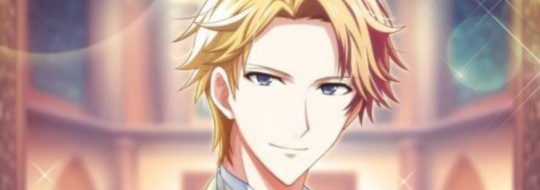
☆ 𝖓𝖆𝖌𝖎
• yes, just yes
• he will play ANY video games with you, as many as you wanted
• just like Mitsuki, he's amazing at Taiko no Tatsujin, but if you played together, he would let you win a couple of times
• he enjoys most rhythm games, whether mobile, arcade, on a console or in a computer
• he also loves games that are anime styled or even based on anime series
• headcanon he cried A LOT like A LOT when the Madoka Magica game got taken down
• he also might play some anime dating sims
• another headcanon is that he installed Doki Doki Literature Club because he thought it was a cute game and didn't sleep for weeks
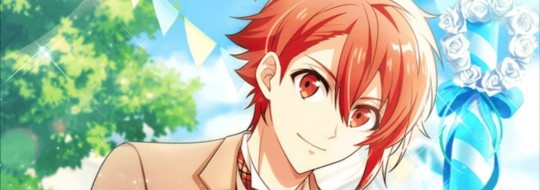
☆ 𝖗𝖎𝖐𝖚
• sure! if it makes you happy, Riku will gladly play video games with you!
• you once got so competitive at Mario Kart he had a asthma attack <3
• he's so cute like a puppy
• he enjoys most types of games, he won't play violent games though
• I just know he loves Animal Crossing
• if you win, he will cheer on you, if you lose, he will comfort you, and if it's a tie, he will say it was a nice and fair game
#idolish7 x gn reader#idolish seven x reader#idolish7 x male reader#idolish7 x reader#idolish seven#idolish7#izumi iori#izumi mitsuki#rokuya nagi#nanase riku#yamato nikaido#osaka sogo#yotsuba tamaki
91 notes
·
View notes
Text
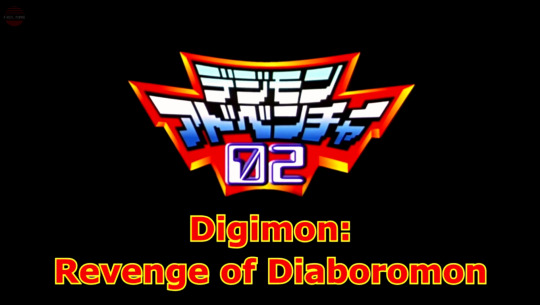
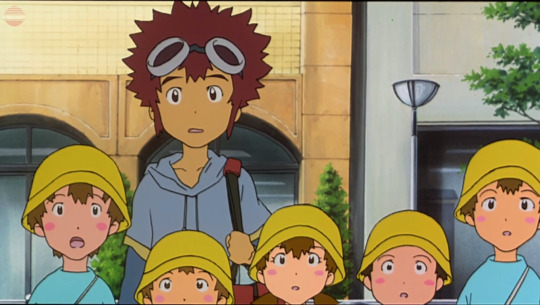

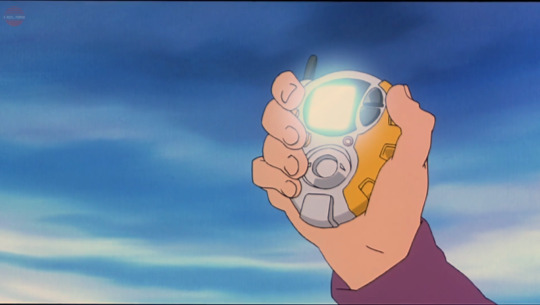


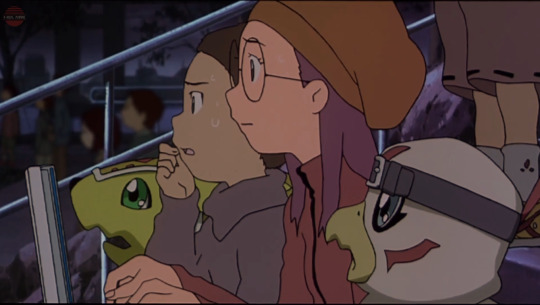


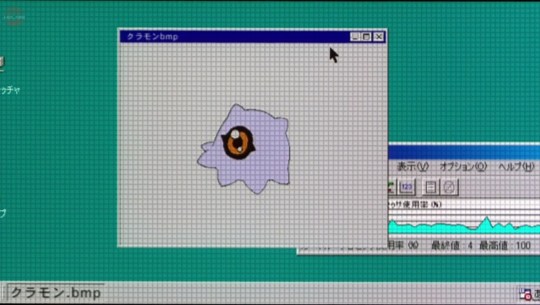
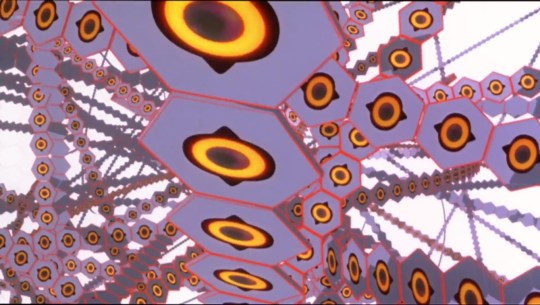

Digimon Adventure 02: Revenge of Diaboromon
Wow...somehow this one just completely fell off my radar, otherwise I would have watched it a long time ago lol. I seriously thought I was all caught up with pre-Tamers anime until I saw this on the 02 TV Tropes and was like "oop..." It was a good surprise though, I can never get enough of these Mamoru Hosoda style shorts! (Looks like he didn't actually work on this one though).
I watched this dubbed first to take screenshots and then subbed. It's hard to find a non-crunchy version of the subbed short. The OG Japanese was a lot stronger imo because, as usual, the dub ruined some stuff with it's jokey tone and music choices. Still decently faithful though. Full thoughts below.
Notes:
So this is like a midquel, I guess. I don't know if there's an exact place within 02 I was supposed to watch this, but I didn't feel like my immersion was wrecked or anything haha.
While the aesthetic of the short was great, I felt the story was pretty redundant and eye-roll worthy. "Oh Omegamon/Omnimon is back for some contrived reason and the OG chosen children's digimon can't defeat him like they did last time...for some contrived reason. This looks like a job for the 02 protagonists!" Whatever, it doesn't have to be deep to be fun.
The early 2000s CG looked pretty good actually. I thought it added a fun otherworldliness to the Kuramon.
Kuramon look a lot like Takodachi (Hololive fans know what's up). I wonder if there was some inspiration there on a subliminal level.
I wonder if Daisuke's character designer intended him to be from a southern part of Japan. His tan skin sticks out more in this art style.
I feel like Diaboromon got uglier somehow compared to Our War Game lol. Armagemon's design was deliciously creepy though. He looked like something out of an Alien movie. His entrance was epic and probably would have freaked me out a lot as a kid. Weirdly, they never actually said Armagemon's name so I just assumed it was Diaboromon until I googled it just now lol
Sora and Mimi were like two sides of the same coin in this. Mimi was useless, but in a delightful way. Sora was useless, but in a boring way lol. Seriously, she didn't need to come all the way home from her tennis club trip to just go "I'm here!" and then do nothing. I'm not saying there was much she could do anyway, but I get really pissed that they never gave her character a real point aside from "bland love interest" in any Digimon show/movie.
Loved Mimi's interactions with Koushiro. Their awkward "we're in the same friend group but have nothing in common" chemistry is so fun.
Yamato seemed extra cool with his rings and stoicism. I do kind of wish he and Taichi got a little more dialogue though.
Really didn't like the direction of the fights inside the internet. They were either animated too up close or too distant so I felt like I couldn't really follow what was going on half the time. Also, the choreography wasn't that inspired. The IRL fight at least had a cool Evangelion vibe going for it. The harbor was a really aesthetic setting for a final fight.
I've started shipping DaiKen for funsies (there's some really cute fanart) so it was nice seeing them together in the elevated art style hehe.
Daisuke has a Yamato phone strap! So cute and supportive

It's funny how the digimon sizing suddenly changes when we're in movie-mode. Angemon and Angewomon were huge in this! I was excited to see the 02 digimon, but they mostly looked the same as they looked in the show tbh.
The Shibuya vibes, complete with Hachiko statue, were fun. Was 02 set in Tokyo? I honestly don't remember...
Seeing all those children running around at night without any worries about safety...must be nice, Japan.
When Omegamon "ran out of energy," I had the thought of like "can a jogress digimon die in the real world or would they always just de-digivolve??" I guess they'd never go that far for plot reasons anyways
Imperialdramon gets a new mode! Paladin mode, according to Google. Were these names in the credits or did they just decide things later for the TCG or something...?
We got the 02 theme inserted towards the end and even the OG show's theme as a ring tone. Really cute touch. (I was a little triggered to hear Bolero again for the millionth time though).
All in all I'm glad the 02 kids got their due in this style. Was it groundbreaking? No. Was it worth 30 minutes of my time? Absolutely!
21 notes
·
View notes
Text
'70s Japan Trends Through the Music Charts (Part 4)
During the 1970s, the Japanese music industry was in the process of forming its identity. In addition to mirroring the musical preferences of the nation, the charts also served as a reflection of the prevailing societal trends and ambitions of that era. In this series, we chronicle the most significant musical trends of the decade.
'70s Japan Trends Through the Music Charts (Part 1)
’70s Japan Trend Through the Music Charts (Part 2)
70s Japan Trends Through the Music Charts (Part 3)
Trend #10: Yazawa, Okura, Carol, and the Origins of Japanese Rock 'n' Roll
The US occupation of Japan ushered in a wave of Western exports to the archipelago, among them one of the most celebrated music genres: rock 'n' roll.
Initially, the domestic itineration of the style could only produce fleeting fads like the rockabilly boom of the 50s and the "group sound" band phenomenon in the 60s. But, by the 70s, rock music had transformed all established genres. There were enka rock bands, such as DOWNTOWN BOOGIE WOOGIE BAND. Its leading man, Ryudo Uzaki, was a prolific composer, adding tinges of rock to the kayokyoku sung by fresh-faced idols like Momoe Yamaguchi. Kenji Sawada, the former vocalist of group sound band The Tigers, technically considered an "idol" back then, carried himself like a true rockstar. And, of course, the trendiest style was folk, which, inspired by US folk rock, launched multiple singer/songwriters to stardom.
While Japanese rock was everywhere, it was also nowhere. The concept of "local rock" was nonexistent at the beginning of the decade. The prevailing belief was that the Japanese language and pronunciation couldn't synchronize with the rhythms of rock music, making it impossible for a domestic version of the genre to thrive. However, this notion was upended in 1972 when Japan's first true rockstar, Eikichi Yazawa, emerged.
Yazawa's journey began in post-atomic Hiroshima. Raised in poverty by his paternal grandmother after his mother abandoned him and his father died of a radiation-related illness, Yazawa found solace in Western music heard on the radio. A fervent Beatles fan, he was inspired to pursue a career in music after going to a live concert by The Ventures, another popular foreign rock band, in his hometown. In 1968, immediately after graduating high school, he embarked on a journey to Tokyo, hoping to make a name for himself as a musician. But he was feeling pain in his buttocks from sitting for too long, so he decided to get off in Yokohama, encouraged by the fact that it was a port city, just like Liverpool.
In Yokohama, Yazawa had his solo demos rejected by all the major labels. Determined to pursue his rockstar dream, he formed a band called YAMATO, which gained some popularity playing at various night venues in the area. However, YAMATO disbanded in 1971 as its members went their separate ways. Undeterred, Yazawa continued his quest for rock stardom and held auditions for a new band, "Carol."
Carol was founded by Yazawa, who served as its vocalist, bass player, and composer. But he found a kindred creative spirit in Johnny Okura, their guitarist and lyricist, who was instrumental in shaping the band's identity. Okura conceptualized Carol's style, drawing inspiration from The Beatles during their early days in Hamburg when they played '50s rock in gritty German clubs. He also played a significant role in crafting their distinctive image, with members donning edgy leather jackets reminiscent of bikers and sporting pompadour hairstyles. Their unique aesthetic and sound quickly set them apart in the Tokyo live music scene.
Despite being a key creative force, Okura's erratic behavior and lifestyle sometimes posed challenges. When Carol booked their first shows, Okura was hospitalized in a psychiatric hospital, rendering him unreachable. In contrast, Yazawa's professionalism, meticulous management, and unwavering ambition held the band together. He took charge of negotiations for concert fees and organized their schedules.
While "real musicians," like folk stars, rejected invitations from TV stations, Yazawa recognized the medium's power and believed securing a TV slot could propel the band to stardom. But it was Okura who identified the perfect opportunity when Fuji TV's youth-oriented show "Live Young" issued a call for "Roxy fashion performers."
Airing on Saturdays, "Live Young" functioned as a televised version of the influential magazine Heibon Punch, spotlighting fashion and music trends appealing to young adults. "Roxy fashion," which was all the rage in London then, was inspired by the glam British rock band Roxy Music. Like Carol, the Bryan Ferry-led band featured visual elements reminiscent of '50s fashion, but the show's staff was uninterested and initially ignored their submission.
In response, an indignant Yazawa contacted the producers, arguing that excluding Carol, a band heavily influenced by the Roxy fashion, was a grave oversight. This assertion was a bluff; the visual resemblance was unintentional, but it worked. On October 8, 1972, Carol appeared on the Roxy fashion episode, captivating the audience with their leather jackets, pompadour hairstyles, and renditions of classic rock hits like "Johnny B. Goode" and "Good Old Rock 'n' Roll." Their appearance generated significant buzz, leading to a major label signing them just three days later.
While Carol's breakthrough was in a program linked to Heibon Punch magazine, a rival publication, Weekly Playboy, became a crucial ally in promoting the band. Weekly Playboy targeted young men, much like Heibon Punch. Still, it appealed more to working-class youth, fostering a dynamic that Shueisha, the publisher, would later replicate with other titles (AnAn's rival, Non-no, which, like Weekly Playboy, would quickly eclipse its competitor's sales). With their leather-clad appearance, extravagant hairstyles, and motorcycles, Yazawa and his bandmates resonated strongly with the magazine's readership. Consequently, editors frequently featured the band and their striking "yankee" style.

Carol's sound had a historical impact on Japanese rock music, while its aesthetic changed local fashion and fueled the "yankee" sub-culture that would take over the country in the following decade.
In Japanese culture, "yankee" is a term commonly associated with delinquent youth and their distinctive appearance. While the word remains in use, its cultural significance reached its zenith in the 1980s when teenage motorcycle gangs took over the country, revolutionizing youth culture. However, in the early 1970s, a decade before getting hold of the nation, Carol's popularity contributed significantly to the rise of the "yankee" style.
The band wasn't alone in popularizing the 50s biker/rocker aesthetic. Some Tokyo fashionistas gravitated to the trend due to the Roxy fashion movement in London. Meanwhile, in schools around the country, teen rebels were multiplying. It was a perfect storm for the "yankee" style surge, cemented by Carol's emergence into the mainstream. The band's dynamic presence and unique appeal made Yazawa and his bandmates role models for the emerging youth culture tribe.
Bosozoku ("running-out-of-control") -- gangs of teenagers with little regard for laws, who'd run around provincial Japan in their customized motorcycles -- adopted Eikichi Yazawa as their ultimate god. They'd often escort Carol band members to their concerts.
But the bond between blue-collar young people and Yazawa was a natural development as Carol's leading man truly represented something unique to Japan up to that point, a working-class rock 'n' roll icon. His superstar aura yielded excellent results for the band, quickly attracting tens of thousands to their live concerts.
Band members frequently smoked and drank on stage, creating an electrifying environment. Fights and disturbances sometimes erupted during their shows, eventually leading city halls to decline to host their concerts due to fears of property damage. Paradoxically, that pulsating, feral energy was precisely what made their shows such a hot ticket. Soon, influential cultural figures started attending their performances, like the famed photographer Kishin Shinoyama; fashion designer Kansai Yamamoto, who'd invite Carol to perform at one of his Paris fashion shows; and Masayuki Yamazaki, a pioneer of Yankee fashion and Harajuku fashion and nightlife icon.
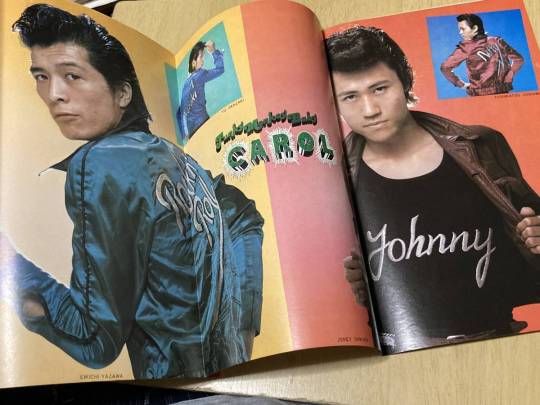
Weekly Playboy was crucial in turning Carol's members into fashion icons and leaders of millions of young men. Above, the 8/21/1970 issue, which opened with a fold-out of the band's most popular members, Eikichi Yazawa and Johnny Okura.
In February 1973, another influential figure, Jin Tatsumura, attended one of these concerts. At the time, Tatsumura, a 33-year-old NHK director from a high-society background, wasn't the band's primary audience, but he found himself captivated by the energy and fervor of the performance. Given his role overseeing NHK's documentary content, Tatsumura left the live show with an overwhelming desire to create a special documentary about the band for the national broadcaster. He believed the culture surrounding Carol perfectly encapsulated a new type of post-war youth movement.
Tatsumura poured his heart and soul into creating the Carol documentary, making it his passion project. By July, he had completed production with plans to broadcast it in prime time at the end of the month. However, to his astonishment, when the day arrived, only a nine-minute edited version of his work was aired. NHK's higher-ups deemed the debauchery and rebellious behavior associated with the band unsuitable for the public network's clean and wholesome image.
This left Tatsumura furious. Not only did he initiate legal proceedings against NHK, but he also decided to release his censored documentary in cinemas. Consequently, the public broadcaster terminated his employment and banned Carol from its airwaves. For a band well aware of the media's promotional power, being banned from the country's most influential network could have been detrimental. However, it only enhanced their status as anti-establishment icons, further fueling their popularity.
While Carol left an indelible mark on fashion and youth culture, their most significant musical legacy was proving once and for all that Japanese rock music could thrive.
Until then, Japanese song composition adhered to a rigid formula, with lyrics expected to resemble Japanese poetry. This meant sticking to a specific syllable count that dictated the song's rhythmic structure, in contrast to the more free-flowing lyrics of Western music. Moreover, many believed that the phonetics and structure of the Japanese language couldn't synchronize with the rhythm of rock.
Yazawa and Okura never wasted any time in that debate. They just went ahead and recorded their rock tunes in Japanese. And the public loved it. No one could dispute that they were rock stars playing rock music, so the debate on the viability of local rock was buried once and for all.
It wasn't just the sound, of course. Carol had to sell an image and lifestyle convincingly to break misconceptions about being genuine rockers. Yazawa's professionalism, panache, and life story – akin to the "American dream" mythology of a working-class young man coming from nowhere and achieving his ultimate dream – helped them achieve this. Still, to become the first commercially successful Japanese rockers, Yazawa and co. had to introduce some stylistic innovations to local music.
Their television debut captured the hearts of the masses as they performed English-language rock classics like "Johnny B. Goode." Since these songs were relatively unknown in Japan, many assumed they were original compositions, especially since one of the band members was also named Johnny. The electrifying segment generated immense excitement, leading the Nippon Phonogram/Phillips label to sign them and launch an aggressive marketing campaign. Starting in December, less than two months after their Fuji TV debut, Carol released singles every month.
Their debut single, "Louisiana," initially featured English lyrics by Johnny Okura. However, at the last minute, the label requested a switch to Japanese, believing it would be more commercially viable. At that point, Okura and Yazawa devised a unique lyric-writing method. Rather than striving for cohesion, they crafted lyrics that freely matched the rhythm, peppering them with sporadic English phrases like "oh yeah" and "oh baby." This unconventional approach struck a chord, as "Louisiana" became a hit, solidifying the presence of Japanese-language rock.
Yazawa also adopted a distinctive singing style called the "rolling tongue" method. This involved singing in Japanese but with an American accent. For example, instead of pronouncing a sentence like "ore no kanojyo" with proper Japanese pronunciation, he rendered it in the style of an American English phrase: "orrei nou kanoujyou."
These innovations were warmly embraced by the public. In particular, with their seventh single, "Funky Monkey Baby," achieved monumental success and became a timeless Japanese rock classic.
At the outset of 1975, despite their tremendous success, the members of Carol found themselves at odds and decided to part ways. Their farewell concert at the Hibiya Open Air Concert Hall drew 7,000 fans, doubling the venue's 3,000-person capacity. Several months later, TBS broadcast the live performance as a special episode of their popular variety show, "Ginza Now!" Staying true to Carol's style, fireworks intended for special effects accidentally ignited due to rain, resulting in the band's illuminated sign burning down and collapsing. This unscripted moment only added to the event's legendary status.
Following the band's breakup, attention turned to the songwriting duo of Okura and Yazawa, often compared to Lennon and McCartney. Although their creative synergy was evident, their clashing personalities ensured they would never reunite.
Okura, with his free-spirited mindset and erratic behavior, including a struggle with drug addiction and the revelation in 1975 that he was a "zainichi" (a Japanese-born Korean, Japan's most prominent ethnic minority, frequently subject to racism and prejudice), couldn't assimilate into Japan's conservative, buttoned-up showbiz scene. In the 1980s, he succeeded as an actor, winning a Japan Academy Award and receiving prestigious offers, including an invitation to participate in NHK's historical drama. However, an incident in 1987, in which he fell from the balcony of his seventh-floor hotel room, derailed his career, pushing him off the mainstream radar and into the underground scene, where perhaps he felt more comfortable. Okura passed away in 2014 at the age of 69.
In contrast, Yazawa embarked on a different path. With his striking good looks, remarkable style, talent, and legendary work ethic, he emerged as one of Japan's most prominent artists, with his solo career overshadowing the success of the band that propelled him to stardom.
Initially, however, his solo career faced significant hurdles.
Ever the consummate professional, Yazawa worked behind the scenes to ensure a seamless transition to a solo career. He signed a contract with Sony/CBS, borrowing funds from the label to extricate himself from his previous Phillips deal. He allocated all his Carol royalties to spend several months on the West Coast of the United States, recording his new album. However, upon returning to Japan to launch his new phase as a solo artist, he struggled to connect with his audience. The public yearned for more of Carol, not a solo Eikichi Yazawa. His concert tickets didn't sell, and his new music failed to resonate.
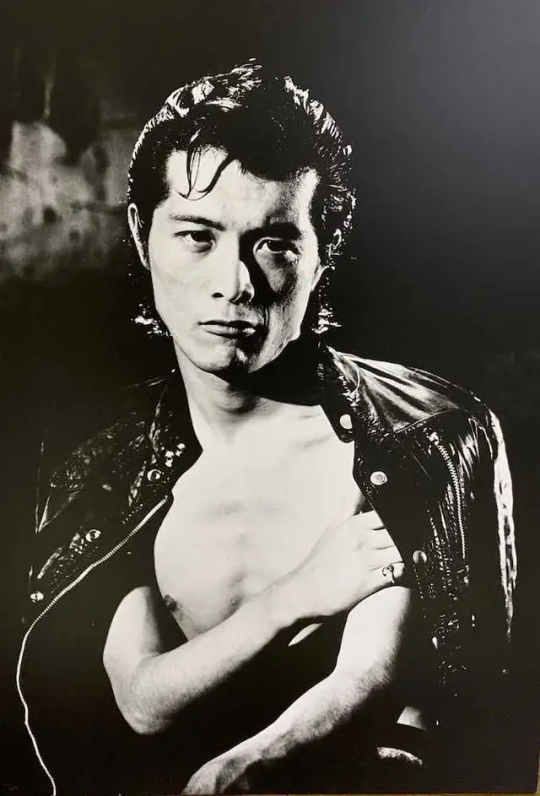
Eikichi Yazawa, from one of the minds behind Carol to a legendary solo act.
Despite the negative chatter, Yazawa remained steadfast in his belief that the public would eventually embrace him as a solo artist with a different, more ballad-oriented rock sound and style. He held live concerts to cultivate loyalty, and his determination paid off. By the end of July 1976, his Hibiya Open Air concert attracted 7,000 attendees, a turnout similar to Carol's farewell show.
The subsequent year saw him embark on an extensive tour, becoming the first local rock soloist to grace the stage at the Budokan. His single "Jikan yo tomare" (Stop Time), featured as the soundtrack for Shiseido cosmetics commercials, became a million-seller. By March 1978, the demand for his live shows had grown so much that he performed at Japan's largest venue, the Korakuen Stadium. In July of the same year, he further solidified his legendary status by releasing his autobiography, "Nariagari," recounting his journey from rags to riches. The book became a cultural phenomenon and a touchstone for an entire generation, surpassing two million copies in sales. It also shaped Yazawa's public image.
By the 1980s, Yazawa had become Japan's highest-paid musician. As the rock genre flourished throughout the decade, he attained universal recognition in the country as the king of rock. From 1983 onwards and continuing into the present, he consistently hosts sold-out nationwide tours.
Despite his immense success, the rock icon encountered personal crisis, most notably in 1998 when a business partner deceived him, siphoning off nearly $30 million in Australian investments by obtaining loans in his name, leaving him burdened with substantial debts. It took him over a decade, but he ultimately managed to repay all the money to the banks. "I can get big loans again," he cheerfully announced in the mid-2000s when he built a five-story studio in a prime location in Akasaka, a central Tokyo neighborhood.

1978 was the year Eikichi Yazawa solidified himself as Japan's top star. In January, he released the million-selling single "Jikan yo tomare," which was used in Shiseido's commercials and became one of his trademark songs (Ryuichi Sakamoto played the keyboard in the song). His fourth and best-selling studio album, "Golden Rush," came out in June, followed, in the next month, by his epoch-making best-selling autobiography, "Narigari," which would ignite a social phenomenon. In August, he became the first rock soloist to perform at the Korakuen Stadium in Tokyo.
Notwithstanding the embezzlement case, Yazawa is known for his business acumen. Since Carol's dissolution, he secured publishing rights for his work and gained control over his merchandise, a rare feat in Japanese show business. In 2008, he took a bold step by establishing his independent recording company to release his work. While numerous Japanese recording artists had previously explored the independent route, notably the folk superstars of the 1970s with their "For Life" venture, Yazawa stood as the singular success story in this endeavor.
With his records still debuting at the top of the charts, Yazawa held a stadium tour in 2022. Alongside Kenji Sawada, he is the only male soloist from the 70s capable of attracting such large crowds. If, in the mid-70s, his band terrorized NHK's higher-ups, the public network celebrated his career's 60th anniversary in 2022 with a series of primetime TV specials.
This is the unparalleled force of rock 'n' roll. Or, at the very least, it is the unprecedented force of Eikiichi Yazawa, the one who first gave the masses a taste of the rock lifestyle.
Trend #11: I Love Rock 'n' Roll
The success of Carol in the early 1970s definitively ended the question of whether Japanese rock could thrive. As the decade drew to a close, major record labels began reaping significant profits from the genre. In 1979, the progressive rock band Godiego emerged as the top-selling act of the year, surpassing idols, enka, and folk stars. However, their ascent to the top of the music charts was not due to any groundbreaking innovation. Instead, they relied on a very effective J-entertainment technique: commercial partnerships and tie-ins.
After signing Godiego in 1977, the Nippon Columbia label did not spare money for the band's promotion. Their debut single served as the soundtrack for Kanebo's cosmetics commercials, and subsequently, all their songs were chosen as themes for various TV shows and movies. However, the actual turning point came when their 7th and 8th single, "Gandhara" and "Monkey Magic," were featured as the closing and opening songs, respectively, for the top-rated NTV historical comic drama "Saiyuki" ("Journey to the West," also known internationally as "Monkey"). Riding on the coattails of the show's success, both songs became massive hits, catapulting Godiego to the forefront of the music scene.
After two years of Pink Lady's hip-thrusting disco idol pop domination, local audiences recognized a rock band at the top of the charts as a refreshing change. Their follow-up single, "Beautiful Name," was used as a UNICEF charity song, giving them another hit. Their fortune continued with the highly coveted opportunity to provide the theme for the animated "Galaxy Express 999" movie, based on Leiji Yamamoto's sci-fi manga.
Five years earlier, a TV anime adaptation of Yamamoto's seminal work, "Spaceship Battle Yamamoto," had been among the first Japanese animated works to achieve immense popularity, captivating children, teenagers, and adults alike. Its success laid the foundation for Japan's burgeoning "otaku" industry. Consequently, expectations ran high in 1979 for the big-screen anime remake of another of Matsumoto's works. By performing the movie's theme song, Godiego was assured of another hit.
By the end of 1979, the progressive rock band had secured the best-selling album and claimed four of that year's 30 top-selling singles.
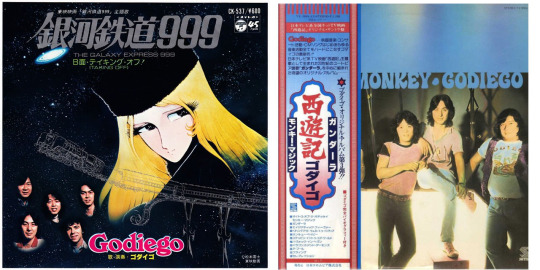
Tie-in with successful TV shows, anime, and UNICEF made the progressive rock band Godiego into the biggest act of 1979.
While good marketing can give you a great year of sales, it doesn't guarantee a prominent position in history books. Achievements based on good tie-ups and marketing are inherently ephemeral, in contrast, for example, to Carol's pivotal role in mainstreaming Japanese-language rock. As expected, the following year saw the local public's attention shift to other trendy acts, causing Godiego to quickly turn into a relic of the past.
But in the year Godiego reigned supreme, a few positions down from them, another band also had a terrific year. With their sophomore album, "10 Numbers Karatto," Southern All Stars had the third top-selling album of 1979. Their single, "Itoshi no Erii" (My Dear Elie), also performed impressively on the singles charts. Although their numbers didn't quite match Godiego's, they would ultimately have the last laugh, establishing themselves as the country's most thriving musical act of all time, with an enduring career spanning five decades. While some would become footnotes in history, Southern All Stars would warrant entire books dedicated to their profound impact on Japanese music.
Before entering history, the five-member band led by Keisuke Kawata was one of Japan's numerous college rock bands, formed at Tokyo's ritzy Aoyama Gakuin University in 1974. They inked a deal with a major label and agency in 1977 after gaining recognition as one of the highlights of the traditional Yamaha Song Contest. In 1978, their first single, "Katte ni Sinbad," whose title referenced hit songs from two of the country's biggest music stars (Kenji Sawada's "Katte ni Shigare" and Pink Lady's "Nagisa no Sinbad"), quickly turned into a hit.
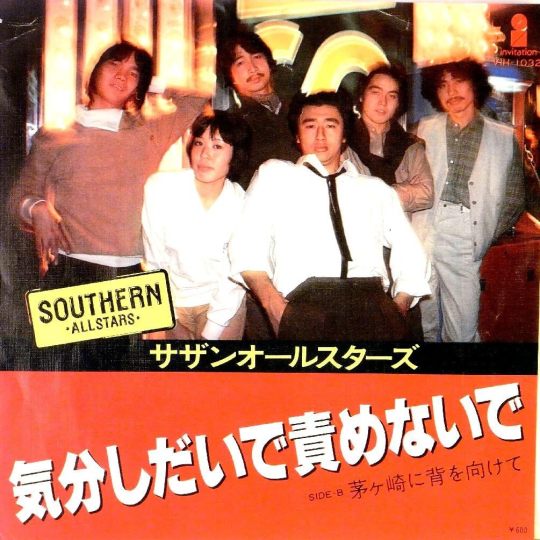
Southern All Stars, seen above on the cover of their second single, "Kibun Shidai de Semenaide."
What set Southern All Stars apart from the outset was their distinctiveness. Initially categorized as "folk," the trendy genre of the era, they were a band from an elite Tokyo university whose sound was infused with exotic foreign influences. Today, their reach and impact are vast enough to be recognized as "J-pop," the most universally appealing contemporary genre. However, akin to Carol, they also played a pivotal role in demonstrating the viability of Japanese rock.
Like Johnny Okura before him, Keisuke Kuwata discarded the rulebook on composition. Lyrics no longer needed to conform to a predetermined syllable count, emulating Japanese poetry; they merely had to synchronize with the rhythm. "Katte ni Sinbad," influenced by Latin music, featured nonsensical lyrics yet emerged as a major hit, marking a watershed moment in local music.
But that was just the beginning for Southern All-Stars. They refused to adhere to a fixed formula. Their lyrics ranged from nonsensical to cohesive, going from traditional to invented words. Their music incorporated samba, reggae, rock, pop, and folk influences. They demonstrated that there was no one-size-fits-all approach for Japanese musicians to follow. The audience eagerly joined them on this musical expedition, pushing the boundaries of what was acceptable in Japanese music.
And with that lesson, the '70s came to a close.
#carol#eikichi yazawa#johnny okura#heibon punch#weekly playboy#j-rock#j rock#70s japan#70s japanese music#godiego#southern all stars#keisuke kuwata#leiji yamamoto
3 notes
·
View notes
Text
F/Ovember for the murderous old man yaoi fan club

I haven't really interacted with the larger f/o/selfship community before. But after seeing @cherry-bomb-ships F/Ovember I thought I would start! Feel free to send in as many asks as you want, about as many F/Os as you want. I'm a bit of a boomer when it comes to this kind of stuff though, so I might not be super good/accurate with it.
Also I will most likely be answering my One Piece F/O asks the most bc that is my current hyperfixation/Special Interest. But I love them all equally so send in asks for whoever you'd like
Also Also, I have no problems with sharing so don't worry about that :) if you need to softblock me for sharing an F/O you're not comfortable with sharing however, that's a-okay!

A neat little list of my F/Os so you don't have to go digging through my messy intro post <3
Romantic:
Elliot (Stardew Valley)
Negan (TWD)
Billy Loomis (Scream 1996)
William Afton (FNAF)
Starscream (Transformers)
Goromi/Majima (Yakuza game series)
Spamton G Spamton (Deltarune)
Sir Crocodile (One Piece)
Buggy D Clown (One Piece)
Dracule Mihawk (One Piece)
QPPs/Semi-Romantic:
Sam (Stardew Valley)
Alex (Stardew Valley)
Hayley (Stardew Valley)
Yamato (One Piece)
Corazon (One Piece)

I'm also reblogging a ton of posts with a list of questions, so feel free to look through those or even make your own!
I have a ton more obviously *but* putting them all for all relationship types would just overwhelm me so I'm keeping them to my main Romantic loves/QPPs. It helps that those are also the characters I know the most about.
#f/ovember#fovember#f/o#f/o community#f/o ask game#self ship#self ship community#self shipping community#selfship community#f/o takeover#s/i x canon#s/i community#fictional other#fictional others#fictional other community#f/os#romantic f/o#platonic f/o#canon x self insert
4 notes
·
View notes
Text
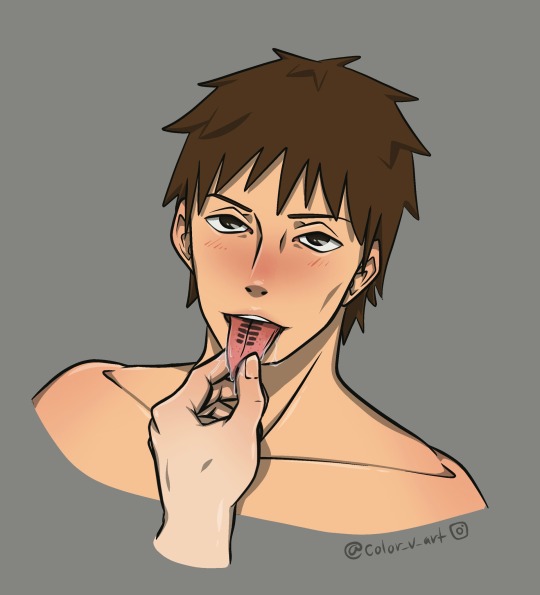
Show me your seal 👅😏
#art#tenzou#yamato tenzo#naruto characters#yamato#naruto shippuden#digital art#fun doodles#kakayama#captain yamato#y’all know whose hand that is#procreate#ipad art#anime fanart#naruto fanart#yamato fan club#not so shy
55 notes
·
View notes
Text
Mitsuki Izumi Sugao Rabbit Chat - Part 3: A day of relaxing

Part 1 | Part 2 | Part 3 | Part 4 | Part 5
ㅤ
Mitsuki: Manager!
Mitsuki: I’ve fulfilled my promise, and performed a hat trick!
Mitsuki:

Tsumugi: Wow~~! You really did it, as expected of Mitsuki-san!!
Tsumugi:

Mitsuki: I really didn’t think that I could do it, so I was shocked as well ww
Mitsuki: But it was because I had Tsunashi-san to assist me that I was able to do it! He always passed me the ball with perfect timing! Both of our teams had the same score throughout the game, and in the end I managed to score a goal during the additional time, it feels great~!
Tsumugi: The match sounds intense…!
Mitsuki: Momo-san also managed to score two goals, his physical strength and fitness are still very strong after all.
Mitsuki: Though after the match was over, everyone was super tired ww
Tsumugi: Sounds like everyone had a fun time, that’s amazing to hear!
Tsumugi:

Tsumugi: Are you back at the dorm now?
Mitsuki: I’ve finished tasting our victory barbeque, so I’ve just arrived at the dorm!
Mitsuki: Although I’m not that drunk, Iori was still very worried about me so he made me some miso soup~!
Tsumugi: As expected of Iori-san…! How considerate!
Mitsuki: Yeah, that really is the case!!!
Mitsuki: My younger brother is capable and considerate and smart, he’s the absolute best~~~~!!
Mitsuki:

ㅤ
Choices:
Option 1 - Did Iori-san say anything?
Mitsuki: I gave him a big hug the moment I got back to the dorm, so he gave me a puzzled look and asked “Are you drunk!?” and such ww
Mitsuki: He was lecturing me on how I shouldn’t drink too much while pouring me a glass of water!
ㅤ
Option 2 - What flavor was the soup?
Mitsuki: The soup was clam flavored! [1] I think he overheard that I was meeting up with the sports club, and guessed that we would go drinking together before returning home, so he prepared it in advance! It really makes me feel all warm inside~
ㅤ
Option 3 - Did anyone else say anything?
Mitsuki: I think Yamato was also drinking beer alone at home, so we’re both drinking clam miso soup right now ww
Mitsuki: When I showed him the footage of us playing indoor football, he said something along the lines of “You guys sure are full of vigor~” like he’s an old man who’s a shut-in w
ㅤ
Mitsuki: Although I’m about to head to bed soon, the smell of barbeque is still on me, so I have to shower again~
Tsumugi: You said that you have to shower again, does that mean you’ve already showered before returning home?
Mitsuki: Yup, me, Momo-san, and Tsunashi-san went to the sauna together after we were done with our indoor football match!
Mitsuki: The Neppa shi’s [2] service spirit was amazing!
Tsumugi: By Neppa shi, do you mean the person who fans the heat for the people in the sauna?
Mitsuki: Yeah!
Mitsuki: I think he’s a very well-known Neppa shi, he sure is an energetic person www
Mitsuki: He was shouting “1, 2, 3, heave-ho~~!!!” while fanning, I just couldn’t lose to him, so I shouted “Heave-ho~~~!!!” along with him ww
Tsumugi:

Tsumugi: Is that so!? That feels like it would be very hot…!
Mitsuki: Honestly there was more sweat than when we played indoor football w
Mitsuki: We couldn’t handle it anymore while we were halfway through in the end, so everyone just jumped into the ice bath w
Mitsuki:

Tsumugi: But you all jumped into the ice bath right after you’ve sweated a lot, it must feel nice!
Mitsuki: Mhmm! It was super nice! Plus we also ate lots of delicious meat! This day off really isn’t too bad.
Tsumugi: Only the showering part is left now then! Please do your best!
Mitsuki: Urk, Iori coincidentally asked me to go shower as well…
Mitsuki: Although I really want to sleep, I will still try my best.
ㅤ
End of part 3
ㅤ
[1] - Clam miso soup is a traditional hangover cure in Japan, from what I found on google!
[2] - I couldn’t really find an English equivalent/word for Neppa shi (熱波師), so I just decided to go with that lol
9 notes
·
View notes
Text
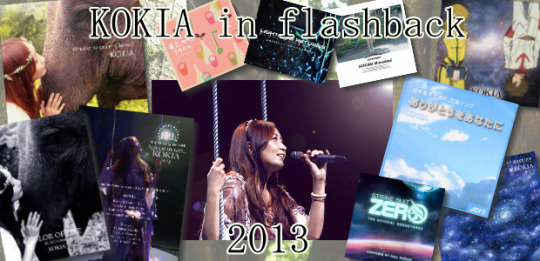
KOKIA in flashback - 2013
The year of 2013 marks KOKIA's 15th anniversary. Having traveled to Bali, Indonesia in the year before, KOKIA has gotten inspired for her 15th anniversary concert and names it COLOR OF LIFE. The accompanying album is called Where to go my love?, although both album and concert are colored by a dramatic event in KOKIA's life. This is the translation of the blog entry she made in March 2013, and this is the translation of her blog post almost ten years later. Holding the anniversary concert anyway, despite wanting to cancel it initially, is what strengthens her resolve to keep singing no matter what.
After the concert, KOKIA takes a break and travels to London, a place she will be returning to more and more often in the future. She also takes up studying English. Her performances in Japan slow down for a while as she finds her footing again, but she assures her fans that she appreciates their support and will continue singing.
◆ Lives and events ◆
January 12
New Year Concert 2013 ~musical greetings vol.2~ (Tokyo, Suntory Hall Blue Rose)
※ 2 performances in 1 day
(Translated blog entry)
April 20
20th Symphony of cherry blossoms and charity concert to save the 1,000 year old cherry blossom trees in Zaou Hall (nara, Kimpusen Temple, Zaou Hall)
(Translated blog entry)
April 28-April 29
KOKIA 15th anniversary concert ~COLOR OF LIFE~ (Tokyo, Bunkamura Orchard Hall)
(Promotion: 15th anniversary)
September 8 (September 14/15/16)
tokai no kakurega concert 5 ('hideout in the city’) (Tokyo, sonorium) ※Event exclusively for members of the KOKIA fanclub, club ancoro, 8 performances total
(Translated blog entry)
October 26
Hokusai Exposed Opening (England, The Old Truman Brewery)
(Translated blog entry)
◆ Releases ◆
March 20
Release of original album Where to go my love? (Victor Entertainment)
September 10
Release of concert DVD 15th anniversary concert COLOR OF LIFE (anco&co.)
(Translated blog entry)
◆ Other releases ◆
January 23
Release of the multi-platform game Strike Suit Zero
※ Soundtrack released simultaneously. Vocals on 4 songs including the main theme.
February 20
Release of the single Battle of destiny (Voice Records)
※ Chapter 2 theme song for the online game Dragon nest
(Blog entry 1, blog entry 2)
March 13
Release of the f.e.n. album Tokyo cafe style #3 fantasies (Mastard Records)
※ Did the solo for Toki o kakeru shoujo ('the girl who leapt through time') as a guest artist, and sang BLIZZARD together with Ayako Ikeda.
(Translated blog entry)
March 27
Release of the single Kioku no hikari ('Light of memories') (Lantis)
※ End theme for the animated movie Uchuu senkan Yamato 2199 dai 4 shou ('Space Battleship Yamato 2199 chapter 4')
(Blog entry 1, blog entry 2)
April
Release of the single Arigatou o anata ni ('thanks, to you') (Japan Youth Assembly)
※Youth Assembly support song
July 24
Release of the Hitomi Shimatani album 15th Anniversary SUPER BEST (avex trax)
※ Composed the song Anata o mune ni ikite yuku ('I’ll live on with you in my heart’)
(Hitomi Shimatani tag)
November 21
Release of LIGHTNING RETURNS:FINAL FANTASY XIII original soundtrack (SQUARE ENIX)
※ Performed a different version of Noel no theme ~saigo no tabi~ ('Noel's theme ~final journey~'): Noel no Theme ~yami no kariudo~ ('Noel's theme ~the shadow hunter~')
◆ Books ◆
April
Album concept photo book COLOR OF LIFE -PHOTO BOOK-
※ Concept photo book for the album Where to go my love?. Includes a bonus CD with the song Kasa o kashite agete ('Lend your umbrella')
(Translated blog entry)
◆ Other ◆
April 25-May 5
Special broadcast on the Yunika Vision screen in front of Seibu Shinjuku station
※ From the KOKIA concert DVD History
(Translated blog entry)
◆ Videos with links to watch ◆
Main theme and others for the 2013 multi-platform game Strike Suit Zero:
Strike Suit Zero Launch Trailer
Offer to compose the song Anata o mune ni ikite yuku ('I’ll live on with you in my heart’) for the 2013 Hitomi Shimatani album 15th Anniversary SUPER BEST:
Hitomi Shimatani / Anata o mune ni ikite yuku 【15th Anniversary SUPER BEST song recording】
2 notes
·
View notes
Photo


[NEWS] Sato Ryuji has been Cast as Wolfgang Amadeus Mozart in the "Ongaku Geki 'Nigero!' ~Mozart's Librettist Lorenzo Da Ponte~"
SUMMARY
Clergyman Da Ponte (Hashimoto Ryousuke), who is also a womanizer and gambler, is driven from Venice and flees to Vienna. But, the shrewd Da Ponte had managed to get a letter of introduction from the Austrian imperial composer, Salieri (Sasai Eisuke). At the time, Salieri was a person who was deeply trusted by the Emperor Joseph II (Murai Kunio) and the most influential person in Vienna in the opera world. Da Ponte had thought that he would be able to curry favour with Salieri and be under the patronage of Joseph II as Joseph II liked Italian opera and Salieri was also an Italian.
As Da Ponte had intended, Salieri, personally, took care of Da Ponte, and Da Ponte finally won the favour of Joseph II. He would also go on to write the libretto for Mozart's (Sato Ryuji) opera. When Mozart's "The Marriage of Figaro" became a success, Da Ponte's reputation was cemented, and he too thought of himself as a genius.
But, when working with the real "genius" that was Mozart, it made Da Ponte realise how ordinary he really was. They were two people who were a complete contrast to each other, but despite being noisy in their conflict with each other, Da Ponte, who was riding on the momentum, completed Mozart's "Don Giovanni" and "Così fan tutte", and he enjoyed the spring of his life.
However, pride comes before a fall. With the passing of Joseph II, winds of change come to Da Ponte's life.
Come, Da Ponte, "let's escape"!
CAST
Hashimoto Ryousuke (A.B.C-Z) as Lorenzo Da Ponte
Sato Ryuji as Wolfgang Amadeus Mozart
Watanabe Miho as Coco
Yamato Yumiki as Barella
Uchikawa Keisuke as Lazarus
Hosomi Daisuke as Casanova
Sasai Eisuke as Salieri
Murai Kunio as Joseph II
NOTE: Sato Ryuji has appeared as a guest on Hashitomo Ryousuke's radio show, A.B.C-Z's "Konya wa J's Club", where he and Ryousuke did a radio drama amongst other things.
To listen to Ryuji's guest appearance on the radio show, please refer to this link: HERE
STAFF
Director and Scriptwriter: Suzuki Katsuhide
Composer: Oshima Goro
NOTE: Suzuki Katsuhide and Oshima Goro have both worked with Sato Ryuji before on the "Rock Opera 'R&J'", which Ryuji starred in as Romeo.
To purchase the DVD for the "Rock Opera 'R&J'", please refer to this link: HERE
To watch the "Rock Opera 'R&J'" online, please refer to this link: HERE
VENUES AND DATES
Fukuoka Performances
Dates: February 10, 2023 to February 12, 2022
Venue: Canal City Theater
Capacity: 1,144 people
Osaka Performances
Dates: February 17, 2023 to February 19, 2022
Venue: Umeda Arts Theater Drama City
Capacity: 898 people
Tokyo Performances
Dates: February 21, 2023 to March 01, 2022
Venue: New National Theatre
Capacity: 1,038 people
GENERAL TICKETING INFORMATION
Sales Start Date: January 15, 2023
Sales Start Time: 10.00 (Japan time)
Price: 10,000 yen
"Nigero!" Official Twitter Account: HERE
"Nigero!" Official Website: HERE
#Nigero#Sato Ryuji#Hashimoto Ryousuke#A.B.C.-Z#Watanabe Miho#Yamato Yumiki#Uchikawa Keisuke#Hosomi Daisuke#Sasai Eisuke#Murai Kunio
4 notes
·
View notes
Text
Silly lil LL au bc @anthropologizing inspired me to do so,, I love dragging my ocs into Idol Hell(tm)
Satomi Yamato
* Satomi had found out about the school idol club once it was made. She was very passionate about idols as a kid and she still was even now, that’s why she wanted to join after all!
* She actually used to be apart of a school idol group in middle school called “Stella” but they had to disband due to the members all going to different schools. She figured by joining this school idol club, she could get a restart again!
* her personality is the same but she cares deeply for her fellow clubmates,, she may seem like a short-tempered tsundere who has a bit of an attitude but the more you get to know her, you’ll see she has a fiery passion for idols and her dream of getting to the Love Live! prelims
Hibiki Saihara
* Hibiki however is different, she’s a huge fan of virtual idol, Hatsune Miku and always watches videos of songs and performances from her in her free time.
* She’s on the more shy and quiet side since she’s the one who gets picked on for being the “perfect little teachers pet” just because she does extremely well in academics
* She didn’t even know what school idols were until she most likely gets scouted but she still doubts her ability to become one bc of how “weak” she is and she lacks confidence in herself
But yea that’s just a lil bit of an idea for the au!! Sorry if it’s all over the place
5 notes
·
View notes